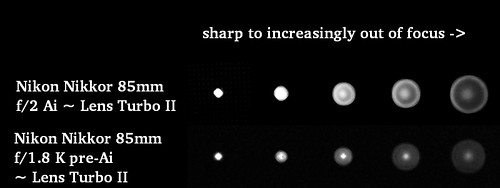Recently I picked up a Nikon Micro-Nikkor 105mm f/4 P Ai lens, thinking and hoping that it's out of focus rendition would be similar to the 55mm Micro-Nikkor lenses I have. Someone on the 'net suggested that the 105mm Micro-Nikkor f/4 is "wickedly" sharp from wide open. So this blog entry takes a look at this and compares its resolution with three other 105mm Nikkor lenses I have on hand.
Setup -
Setup -
- Sony A6000, 100ISO, 2 second delay timer, RawTherapee conversion software
- Big Beefy Manfrotto tripod
- Lenses compared
- Nikon Micro-Nikkor 105mm f/4 P Ai
- Nikon Nikkor 105mm f/2.5 P pre-Ai
- Nikon Nikkor 105mm f/2.5 Ai
- Nikon Nikkor 35mm to 105mm f/3.5 to f/4.5 AiS zoom at 105mm
- Lens Turbo II focal length reducer
It's become obvious to me over the years that nearly all lenses suffer from field curvature. Some lenses, as we might expect, have more pronounced curved fields than others. So to account for this, I have taken to shooting two images at each comparison aperture. The first image is focused in the center of the field, and the second image focuses at the very edge of the field of view. It is important to note that I'm not attempting to measure how much field curvature there is. All I'm looking at is, at the edge of the field, how sharp the optic is. If one photographs flat subject matter, nearly all lens will be more or less out of focus at the edge of the field.
Comparison Results -
[If you click on the image it'll take you to the Flickr hosting site. Once there, look at the file at full resolution. In many cases the differences between lenses is small and likely can't be seen until you take a squint at the comparison at 100 percent.]

Comments -
Comparing the Nikon Micro-Nikkor 105mm f/4 P Ai to the Nikon Nikkor 105mm f/2.5 and f/4.5 zoom, I see that wide open the f/4 Micro-Nikkor lens is indeed quite sharp, though I might not call it "wickedly" sharp. Focusing at the edges of the frame I see that the Micro-Nikkor is slightly less sharp wide open than the center, but that this cleans up very nicely as the aperture is stopped down. As for field curvature (which I am not in any measuring, but simply noting), the Micro-Nikkor suffers from a small amount where the 55mm Micro-Nikkors I looked at do not. I appears to me that to have a perfectly sharp image across a flat field that a user will need to stop down a click or two from wide open.
Looking at the 105mm f/2.5 P and Ai lenses I see that both are sharp in the center wide open. In the corners, too, the non-Ai P 105mm appears to match the 105mm f/2.5 Ai. Though it could be noted that field curvature of the early P non-Ai lens stronger than the updated design Ai. Compared with the Micro-Nikkor, it is difficult to tell a difference when curvature is accounted for in resolution between them across the field. The only note would be that field curvature is less with the Micro-Nikkor than it's f/2.5 brothers.
Comparison Results -
[If you click on the image it'll take you to the Flickr hosting site. Once there, look at the file at full resolution. In many cases the differences between lenses is small and likely can't be seen until you take a squint at the comparison at 100 percent.]

Comments -
Comparing the Nikon Micro-Nikkor 105mm f/4 P Ai to the Nikon Nikkor 105mm f/2.5 and f/4.5 zoom, I see that wide open the f/4 Micro-Nikkor lens is indeed quite sharp, though I might not call it "wickedly" sharp. Focusing at the edges of the frame I see that the Micro-Nikkor is slightly less sharp wide open than the center, but that this cleans up very nicely as the aperture is stopped down. As for field curvature (which I am not in any measuring, but simply noting), the Micro-Nikkor suffers from a small amount where the 55mm Micro-Nikkors I looked at do not. I appears to me that to have a perfectly sharp image across a flat field that a user will need to stop down a click or two from wide open.
Looking at the 105mm f/2.5 P and Ai lenses I see that both are sharp in the center wide open. In the corners, too, the non-Ai P 105mm appears to match the 105mm f/2.5 Ai. Though it could be noted that field curvature of the early P non-Ai lens stronger than the updated design Ai. Compared with the Micro-Nikkor, it is difficult to tell a difference when curvature is accounted for in resolution between them across the field. The only note would be that field curvature is less with the Micro-Nikkor than it's f/2.5 brothers.
Lastly, I took a look at a Nikon Nikkor 35mm-105mm f/3.5-f/4.5 AiS zoom at 105mm. Wide open resolution suffers across the field. Stopped down to f/5.6, however, the lens looks quite good in the center and matches the three fixed focal length 105mm lenses here. At the edges the zoom's resolution appears to clean up rather nicely at f/8. Regarding field curvature, of the four lenses looked at here this zoom shows the most curvature. The curvature is quite dramatic, actually.

